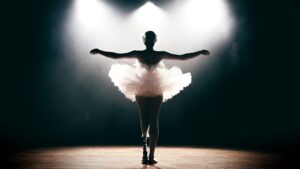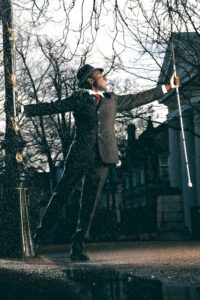The latest evaluation report from Renaisi looks at the impact of Spirit's funding on inclusion and perceptions of disability. People Dancing's Louise Wildish responds to its findings and states that the work must continue.

Louise Wildish responds to new report on perceptions of disability

The Renaisi report commissioned by Spirit of 2012 Changing perceptions of disability through sports, arts, and culture: what works and what challenges exist? explores the lessons learnt from projects funded by the independent trust set up to recreate the pride and positivity of the 2012 London Olympic and Paralympic Games.
First and foremost, this report has an excellent opening explanation and understanding of the quite complex social, medical, and radical models of disability, along with a paragraph on the sensitivity of language around disability − the deeply personal and sometimes politicalised − that not all disabled people agree on. I found this section to be a wonderful synopsis, a reminder, and indeed a good reference tool for any organisation to digest and reference, regardless of their inclusion knowledge and expertise.
An understanding by the writers that: “The report is based on quite limited surveys” and that “No-one from the team who conducted the research identified as disabled” is refreshingly honest and research led by a disabled person is indeed a must, and something to work on in the future. However the report clearly manages to capture disabled voices and representations backed up by important lived experience and evidence.
Overall, the report is detailed and considered, and reminds us that inclusion is incredibly complex and individualised and that unsurprisingly disabled people feel held up by societal and systematic beliefs which more often are based around the medical as opposed to the social model. Society still harbours negative perceptions of disabled people, and disabled children and adults are often segregated and conditioned to view themselves as burdens or unworthy contributors to society. Disabled people themselves have some way to go to feel fully included and empowered, to understand their rights and when and how to voice them.
The evidence here confirms that there is still some way to go to make deep and fundamental change. At the same time it’s encouraging to see both the detail and the range of Spirit’s projects within sport, arts and culture who are making such positive developments, exploring new approaches and forging new ways to drive forward social and attitudinal change.

11 Million Reasons to Dance, photographer Sean Goldthorpe, dancer Sian Green, commissioned by People Dancing
Perceptions of disability and negative perceptions of disabled people
I agree that the public in general still holds a certain aesthetic and perception of disabled people – and that needs to change. As the report highlights, the importance of disabled role models and representation needs to be reflective of society so that role models are not only ‘high achieving’ disabled people, but ‘normal’ disabled people of differing ages, economic, cultural or ethnic backgrounds, and of course differing intersectionalities within disability. Perceptions of disability are often focused on mobility, so how do we broaden people’s awareness and understanding of difference within disability?
What if your disability doesn’t allow for athleticism and your body can’t be pushed? Or you simply don’t want to ‘get on with it’, what then?
In the dance sector, there still seems to be an ‘aesthetic’ with many disabled dancers still falling into the medical model of being aesthetically pleasing or representative of a ‘perceived’ traditional dancer, rather than an individual. At People Dancing we launched a whole campaign around this in 2014 to change the perception of disabled dancers. I mean just look at recent television programmes for example. While it’s wonderful to have made a start on disabled representation on television, increasingly I am seeing disabled people who are no trouble, or fit into the medical model, or the public’s perception or one type of aesthetic of disability. BBC Breakfast’s sofa groans with yet another high-achieving usually white and male disabled athlete, but what if your disability doesn’t allow for athleticism and your body can’t be pushed? Or you simply don’t want to ‘get on with it’, what then? What is the message to disabled people here? Get on with it, push through it, and fit in with the rest of us, and if you can’t you’re a drain on society and are useless? Do you think we will ever see a profoundly disabled person on Strictly? I hope so, but right now, we aren’t witnessing the full picture of disability across society, true representation across all disabled people can also be LGBTQ+, Global Majority and/or have more than one disability at a time, and multiple conditions. So how do we represent intersectionality within disability better? How do we tell and reflect individual stories better?
Mechanisms and barriers to change
The core threads raised in the report are around that of communication, reasonable adjustment, and access for disabled people. Individualised and complex, and weighted in ableist history, the question here is: Are organisations doing enough to ensure that each disabled individual is supported and has their access needs met when participating? And is it the responsibility of the organisation, the disabled person or someone else to initiate and put this in place.
How do organisations know that they are approachable, create the space to welcome in disabled people or even allow that same space for adaption and conversation for a change in our approach to take place? Have organisations considered changing approaches across departments to be fully accessible with an understanding that access support and needs are ongoing and everchanging? If so, how are we supporting that process?
What is also apparent is that disabled people have been generally repressed by society and have had decades of being made to make do, defined by the ‘can’t’ rather than the ‘can’
This opens up training and support issues for an to make sure diversity and inclusion policies are regularly revisited, and operational and budgetary planning meetings have someone whose remit covers inclusion. Is the answer to have all the access that we can in the room all of the time? Ideally, yes. And if a disabled person requires access that exceeds the allocated budget or creates extra work, an extra rest room, BSL, or support worker, does that mean they can’t be included? How many organisations can say that at the beginning of planning and development meetings, in operations, access is the starting point for discussion, that the budget is always there for access as priority no matter what? Where does that responsibility and cost lie?
What is also apparent is that disabled people have been generally repressed by society and have had decades of being made to make do, defined by the ‘can’t’ rather than the ‘can’. Disabled people are used to society not bothering, or trying to get their access needs catered for, so I think that there is also a shift that needs to happen around empowering disabled people to communicate their needs effectively and to know that it is in the benefit of everyone, especially society, for those needs to be met. Only then can disabled people fully participate without barriers and only then will prejudices start to fall away.
The report clearly evidences that when disabled people and their families are listened to and supported with their access needs met and given access to training and opportunities, barriers are mostly removed and engagement can happen.
Co-production with disabled people

11 Million Reasons to Dance, photographer Sean Goldthorpe, dancer Mickel Smithen, commissioned by People Dancing
The report accurately discusses the complex issue of public reaction and response to projects or performances that include, or have been created by, disabled people and whether the work is seen as equal to that of non-disabled creators/participants. How do we fully express the work of disabled people led by disabled leaders, and does the work output or quality matter over the experience/engagement? If we truly want to change perceptions of public and audiences, high quality work in its broadest form will support change.
With the right support or access in place, art, sport and culture created or co-led by disabled artists and participants is equal to that created by non-disabled artists and participants. The question is, how far is an organisation willing to go to get that support in place? Although I wonder if while, for some audiences maybe, we’ve moved away from the ‘ah bless’ and ‘didn’t they do well’s’, to do so fully, quality really matters. It also matters from the point of view of development for the disabled artist/participants and leader. If a disabled leader or artist thought that their work was under par would that person want it shown – would anyone? The important elements are that disabled voices and lived experiences are accurately represented in the creation of the work, as work that comes from an authentic place is rarely low quality. The bigger question is what roles do any non-disabled co-workers/leaders play?
There are a number of artists and organisations currently exploring alternative working models where the disabled person works alongside an artistic or creative support worker who is able to understand, support and at times steer the creative processes involved in projects, as well as being an access support worker. The models being explored are individualised, but as findings and evaluations start to emerge, they are proving to be one way of supporting co-production where the disabled person can take the lead and be represented to make quality work.
Until disabled people are on boards and in senior management positions, change will be slow.
Employment
Without leadership programmes for disabled people and more training and employment of disabled leaders at all levels, across all sectors, very little will change. In the main we still live in a hierarchical society in commerce and experience − knowledge, power, change and influence comes from the top down. Until disabled people are on boards and in senior management positions, change will be slow. Are organisations and companies making the pathways or progression for those individuals clear and without barriers? Given the number of disabled leaders in senior positions, not yet. The question is what can we do about that?
Self-limiting beliefs
The report talks about the importance of gate keepers, disabled role models and leaders, and representation, evidencing that it encourages a change in self-perceptions, self-belief and aspirations of disabled people in general. I couldn’t agree more, and I have written about the absolute fundamental importance of disabled leaders earlier on.
In terms of self-limiting beliefs, we do know that access riders and any form of access support are incredibly useful and at times essential for disabled people to communicate needs and thankfully, they are becoming more common, which means more disabled people are feeling empowered. But with an access rider comes a journey of identity.
Years of societal bias about being a burden, being useless and being ashamed needs to be forgotten.
Firstly, the person must choose to identify as disabled, or at least open up a very personal written conversation around their needs and condition/s that uses terminology around disability. They have to be out as a disabled person professionally and personally, and with that comes fear, fear of all the things society has been telling you for years – that you are useless, a burden on society.
Secondly, an access rider places you in a place of confidence, you have to feel okay with asking for things, realising and understanding that you have the right to have your needs met, that you are not (still) being a burden − that it’s not shameful, that the cost of meeting your needs is deserved and not reserved!
Years of societal bias about being a burden, being useless and being ashamed needs to be forgotten. That in itself is an ever-evolving process and one that I’m not sure many disabled people have overcome or get supported to overcome. So, what of those disabled people who don’t feel confident to translate or communicate their identity around disability and their access needs, or some profoundly disabled people that have someone else communicating for them? Do we make assumptions of needs? What about those who don’t know how or can’t talk or communicate about their disability? A lot of disabled people don’t define as disabled, or don’t publicly want to be seen as disabled.
It’s a complicated, emotional, ever changing and often long journey about identity and disability. We have to make sure that we have an offer for disabled people to be included, that access becomes the norm, no big deal, that role models and disabled leaders are across society in all areas and sectors, that diversity in disability is represented and disabled people are de-segregated and empowered by society.
Good practice, conclusions and recommendations
I know that across the UK there is lots of good practice happening pockets of exceptional excellence, and learning that we need to share far and wide in order to influence others to make change. I don’t know when the bulk of perceptions will change, but I am hopeful that they will, and continue to do so as more disabled people are developed as leaders and that society better represents and understands intersectionality in disability. I also know that as an ageing population, disability is, or will be, a part of most families’ lives at some time or another, and it’s vital that we continue to share that lived experience.
Historically disabled people have been excluded with little to no effort made. As we all notice when someone makes an effort, my question to you is, do you want to be someone who gets noticed for making that effort?
Louise Wildish is Director of Engagement at People Dancing, the development organisation for community and participatory dance.
Further information
- Renaisi Perceptions of Disability report
- Making Routes Reports
- Volunteering Together: Inclusive Volunteering and Disabled People
- Did the London 2012 Paralympic Games change things for disabled people?
- Ten years on: London 2012 Paralympic Games were a turning point for changing attitudes to disabled people
